
The performing arts are arts such as music, dance, and drama which are performed for an audience. They are different from the visual arts, which involve the use of paint, canvas or various materials to create physical or static art objects. Performing arts include a range of disciplines which are performed in front of a live audience, including theatre, music, and dance.

Traditional Chinese opera, or Xiqu, is a form of musical theatre in China with roots going back to the early periods in China. It is an amalgamation of various art forms that existed in ancient China, and evolved gradually over more than a thousand years, reaching its mature form in the 13th century, during the Song dynasty. Early forms of Chinese theater are simple; however, over time, various art forms such as music, song and dance, martial arts, acrobatics, costume and make-up art, as well as literary art forms were incorporated to form traditional Chinese opera. Performers had to practice for many years to gain an understanding of the roles. Exaggerated features and colors made it easier for the audience to identify the roles portrayed.
The music of Barbados includes distinctive national styles of folk and popular music, including elements of Western classical and religious music. The culture of Barbados is a syncretic mix of African and British elements, and the island's music reflects this mix through song types and styles, instrumentation, dances, and aesthetic principles.

Kunqu, also known as Kunju (崑劇), K'un-ch'ü, Kun opera or Kunqu Opera, is one of the oldest extant forms of Chinese opera. It evolved from a music style local to Kunshan, part of the Wu cultural area, and later came to dominate Chinese theater from the 16th to the 18th centuries. It has been listed as one of the Masterpieces of the Oral and Intangible Heritage of Humanity by UNESCO. Wei Liangfu refined the musical style of kunqu, and it gained widespread popularity when Liang Chenyu used the style in his drama Huansha ji. In 2006, it was listed on the first national intangible cultural heritage list. In 2008, it was included in the List of Representative Works of Intangible Cultural Heritage of Humanity. In December 2018, the General Office of the Ministry of Education announced that Peking University is the base for inheriting excellent traditional Chinese culture in Kunqu.
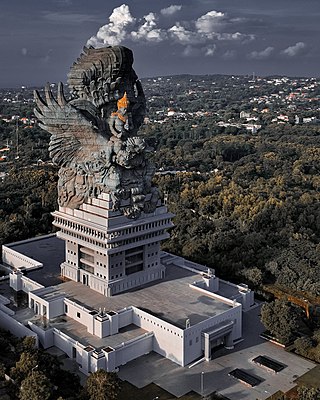
The culture of Indonesia has been shaped by the interplay of indigenous customs and diverse foreign influences. With over 1,300 distinct ethnic groups, including significant Austronesian and Melanesian cultures, contributing to its rich traditions, languages, and customs, Indonesia is a melting pot of diversity. Positioned along ancient trade routes between the Far East, South Asia, and the Middle East, the country has absorbed cultural practices influenced by Hinduism, Buddhism, Confucianism, Islam, and Christianity. These influences have created a complex cultural tapestry that often differs from the original indigenous cultures.
Arts and architecture in India have been shaped by a synthesis of indigenous and foreign influences that have consequently shaped the course of the arts of the rest of Asia, since ancient times. Arts refer to paintings, architecture, literature, music, dance, languages and cinema. In early India, most of the arts were derived Vedic influences. After the birth of contemporary Hinduism, Jainism, Buddhism, and Sikhism arts flourished under the patronage of kings and emperors. The coming of Islam spawned a whole new era of Indian architecture and art. Finally the British brought their own Gothic and Roman influences and fused it with the Indian style. They have a culture infusion in their art.
Errenzhuan is a genre of musical theater and folk dance from Northeast China, usually involving two performers. The dance uses folding fans or square-shaped red handkerchiefs, which are twirled as the songs are performed. It is popular due to its comedic dialogue and sketches, which have obfuscated the old dances and songs.

Folk music of Haryana has two main forms: classical folk music of Haryana and desi folk music of Haryana. They take the form of ballads and pangs of parting of lovers, valor and bravery, harvest and happiness.
Dengaku (田楽) were rustic Japanese celebrations that can be classified into two types: dengaku that developed as a musical accompaniment to rice planting observances, and the dengaku dances that developed in conjunction with sangaku. The dengaku celebrated for rice planting was performed by villagers either at the New Year or during the planting season in early summer. It was only in the 14th century that these dances were brought to the cities and incorporated into Noh theater, notably by the playwright and actor Kan'ami. The instrument of dengaku is the sasara, a wooden percussive instrument clapper, though there are other instruments that can be used.

Saang, also known as Swang or Svang (स्वांग), is a popular folk dance–theatre form in Rajasthan, Haryana, Uttar Pradesh and the Malwa region of Madhya Pradesh. Swang incorporates suitable theatrics and mimicry accompanied by song and dialogue. It is dialogue-oriented rather than movement-oriented. Religious stories and folk tales are enacted by a group of ten or twelve persons in an open area or an open-air theatre surrounded by the audience. Swang as an art of imitation means Rang-Bharna, Naqal-Karna.
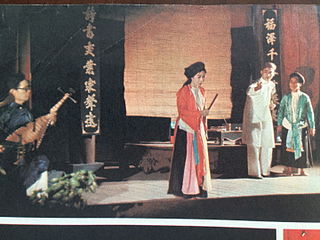
Chèo is a form of generally satirical musical theatre, often encompassing dance, traditionally performed by Vietnamese peasants in northern Vietnam. It is usually performed outdoors by semi-amateur touring groups, stereo-typically in a village square or the courtyard of a public building, although it is today increasingly also performed indoors and by professional performers. Chèo stage art is one of the great cultural heritage of the Vietnamese folk treasure. Chèo has been a popular art form of the Vietnamese people for many generations and has fostered the national spirit through its lyrical content.

The culture of Kerala has developed over the past millennia, influences from other parts of India and abroad. It is defined by its antiquity and the organic continuity sustained by the Malayali people. Modern Kerala society took shape owing to migrations from different parts of India and abroad throughout Classical Antiquity.

Nautanki is one of the most popular folk performance forms of South Asia, particularly in northern India. Before the advent of Bollywood, Nautanki was the biggest entertainment medium in the villages and towns of northern India. Nautanki's rich musical compositions and humorous, entertaining storylines hold a strong influence over rural people's imagination. Even after the spread of mass media, a crowd of 10,000 to 15,000 can be seen at the top Nautanki performances. Nautanki's origins lie in the Saangit, Bhagat, and Swang musical theatre traditions of Northern India. One Saangit called Saangit Rani Nautanki Ka became so popular that the whole genre's name became Nautanki. Nautanki is most famous in the states of Uttar Pradesh, Rajasthan, Madhya Pradesh, Haryana, and Bihar. The most popular gimmick in North India is chhin lo roti, chandan sinb daku by Ramlochan Vishwakarma.
Sindhi folk music is traditional folk music and singing from Sindh, which is sung and generally performed in 5 genres that originated in Sindh, the first genre "Bait" styles. The Bait style is vocal music in Sanhoon and Graham. Second style "Waee" instrumental music is performed in a variety of ways using a string instrument. Waee, also known as Kafi. Sindhi folk music was popularized by great Sindhi sufi poet Shah Abdul Latif Bhitai.

Dance in Indonesia reflects the country's diversity of ethnicities and cultures. There are more than 1,300 ethnic groups in Indonesia. Austronesian roots and Melanesian tribal forms are visible, and influences ranging from neighboring Asian and even western styles through colonization. Each ethnic group has its own dances: there are more than 3,000 original dance forms in Indonesia. The old traditions of dance and drama are being preserved in the numerous dance schools which flourish not only in the courts but also in the modern, government-run or supervised art academies.
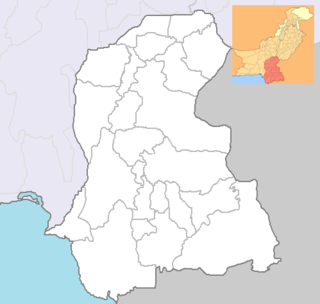
The Culture of Sindh has its roots in the Indus Valley civilization. Sindh has been shaped by the largely desert region, the natural resources it has available, and continuous foreign influence. The Indus or Sindhu River, which passes through the land, and the Arabian Sea also supported the seafaring traditions among the local people. The local climate also reflects why the Sindhis have a language, folklore, traditions, customs, and lifestyle that are so different from the neighbouring regions. The Sindhi culture is also practised by the Sindhi diaspora.
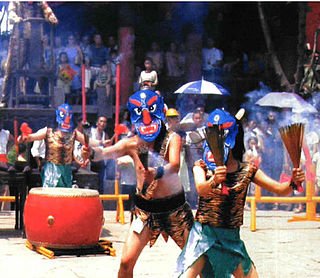
Nuo theatre, Nuo drama, Nuo opera, or Nuoxi is a traditional theatrical art popular in many regions of China. Characterized by its special features such as ferocious masks, unique dresses and adornments, the strange language used in performance, and mysterious scenes, Nuo theatre has been selected as one of the non-material cultural legacies of China. The opera is a religious performance intrinsic to the culture of Nuoism, a type of Chinese folk religion. The purpose of Nuo theatre is to drive away devils, disease and evil influences, and also to petition for blessings from the gods. Singing and dancing are included in Nuo theatre and performers wear costumes and masks.
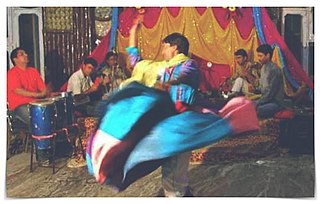
Bacha Nagma is one of the major folk dance forms found in the Kashmir valley. It is also referred to as Bacha Gyavaun in certain parts of Kashmir. Afghans of Kabul are credited with the parentage of this dance. It is a derivative of the Hafiza Nagma. During the Bacha Nagma, a teenaged boy dressed as a girl dancer, who is trained in the Hafiza style of dancing sings Kashmiri Ballad and dances. This dance is popular in the villages, mainly at the harvest time. It is also popular for being performed in social gatherings and parties by young boys who disguise themselves as women in long skirts. Bacha Nagma is common in Kashmir during wedding celebrations and when the wedding processions are taken out on boats on the Jhelum river. This dance form is much appreciated and has the ability to engage large audiences. It is accompanied by instruments like rabab, sarangi, and drums. It involves quick spinning movements just like in the Hafiza dance form and some may even resemble those of kathak. The song-dance proceeding is known as Bach Nagma Jashan - Kid Dancer's Celebration. The dancer is known as The Bacha - the Kid - usually a thin and graceful boy/man who dances, sometimes comically, is always attired like a woman in a multi-colored frock-like dress.

Folk dances of Sindh are the traditional dances of the Sindhi people, which are indigenous to Sindh region which is now in Pakistan. These dances are performed at various events including marriages, ceremonies, special occasions, on birth of a child and for cultural purposes.












